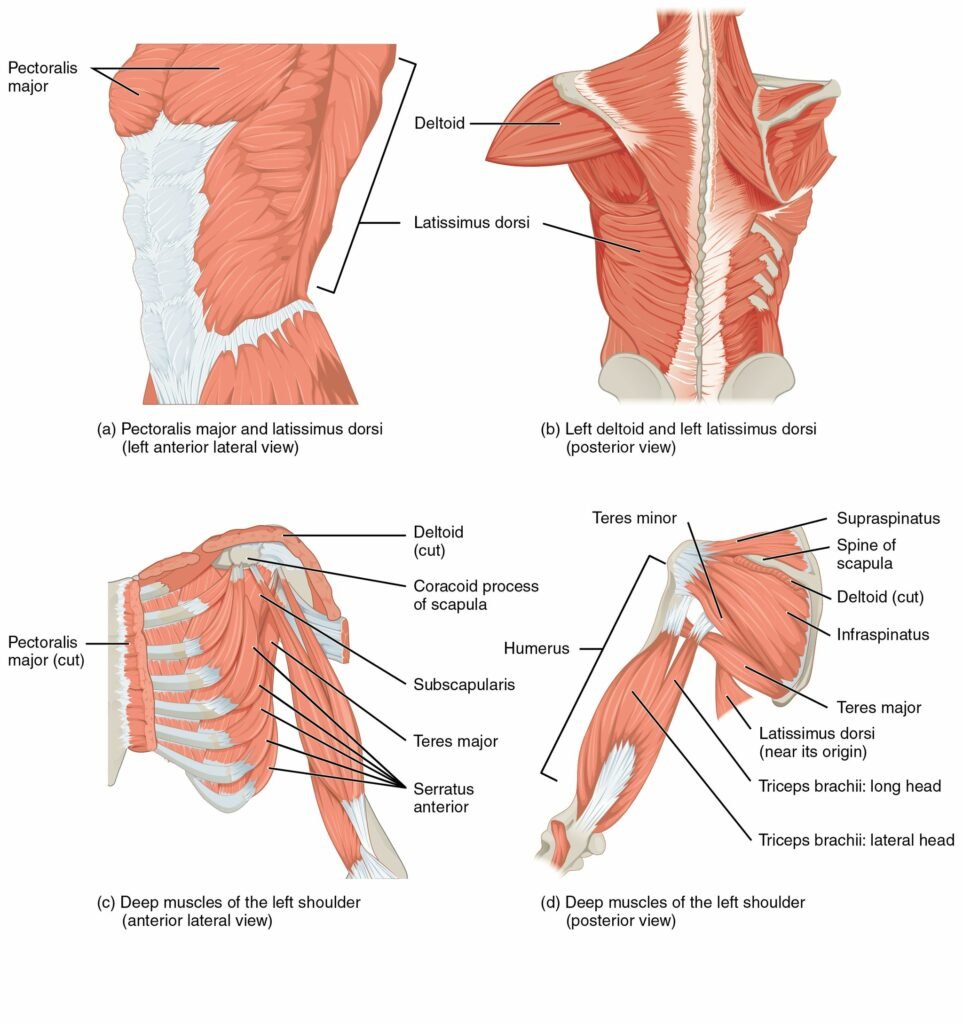
Why Do I Feel My Lats When Doing Push Ups? Problem Solved For Rapid Progress
Have you ever done a set of push ups and felt it in your lats? It can be confusing why your body is working so hard to engage this muscle during this exercise.
As frustrating as it might seem, there’s actually a good reason for this – and if you understand why and how you’re engaging certain muscles while doing exercises, you’ll get more out of each workout!
In this blog post, we’ll answer the burning question “why do I feel pushups in my lats?” We’ll explain the anatomy behind it all: how your latissimus dorsi (lats) are activated with every single rep of push ups and give tips on how to maximise their contribution.
So let’s dive in and figure out exactly why those lats are felt when doing pushups.
Why Do I Feel My Lats When Doing Push Ups?
Your lats are one of the main stabilisers in the body. During a push up, they work to help maintain your posture and ensure that you remain stable during each rep. When done correctly, this will help you to keep your spine aligned and prevent any anterior pelvic tilt (which can lead to back pain). Additionally, weak lats can lead to a lack of control during push ups. This can cause you to struggle with proper form and technique, leading to an inefficient workout. The hand position during a push up also makes the lats more prone to activation. Having your hands too far up or down in relation to your body can also lead to overworking the lats. It is also important to look at any previous sessions you have done that could have activated your lats before doing push ups. The sensation you are feeling might also not be your lats, there’s a good chance it could be either the teres major, rhomboids or serratus anterior as they all contribute to the shoulder and arm stability whilst doing a push up. If you are doing too much volume or not warming up properly, your lats can become restricted in their range of motion (ROM). This can lead to an over-activation of the muscle because of its inability to lengthen and shorten efficiently. If you’ve done exercises like pull-ups or rows, then your lats may already be feeling fatigued and therefore more likely to be felt more during push ups.
New to push-ups?
If you are new to fitness and push ups, then you may be feeling more of a burning sensation in your lats than usual. Don’t worry, this is normal!
As you become stronger and more experienced with push ups, the strain on your lats will decrease as you gain control and stability over the exercise.
For the first few weeks, your body will be getting used to the new stimulus of push ups, so your lats will be working hard to stabilise you and maintain correct form.
This can lead to a greater sensation of burning in your lats than normal, but as you get stronger the strain on them should begin to lessen.
It might be worth you doing easier variations of the exercise to start with, such as knee push ups or wall push ups. This will help you to gain control of your body during the movement and make the exercise easier on your lats.
You could have a case of DOMS (delayed onset muscle soreness). This is perfectly normal and often occurs after a new workout routine, such as push ups.
You might find that your lats aren’t the only thing aching if you’re new to push ups, so don’t be alarmed if you feel soreness in other muscles too.
Form
When performing push ups, it’s important to ensure that your form is correct. This will help you get the most out of every rep and prevent any unnecessary strain or injury.
Make sure you have your hands just wider than shoulder-width apart and that they are flat on the ground. Your body should be in a straight line and your core braced for stability.
Avoid any arching of the lower back, as this can put an undesirable strain on your lats. If you feel any pain in the lower back, then reduce the range of motion (ROM) until you can maintain correct form during the exercise.
It might sound ridiculous that your form could be off when doing a simple push up but incorrect technique can lead to an inefficient workout and injury.
Recruiting other muscles to help with stabilisation is common when your form is questionable, so if you feel your lats working more than usual, then take a step back and assess the situation.
As mentioned above, if you are new to push ups your form might not be perfect at first. This is completely normal and, with practice, the correct technique will become second nature.
Meaning that you won’t feel push ups in your lats as much, if at all.

Stabilisers
Your lats are used as stabilisers and support muscles during push ups. They help to brace your core and keep the body in a straight line, which is essential for good form and muscle recruitment.
This is crucial in order to keep your core and other muscles engaged, as well as to ensure that you are getting the most out of every rep.
Stabilisers are important for all exercises, not just push ups. They are essential in order to maintain correct form and help ensure that the movement is performed efficiently.
Other stabilisers for this exercise include your triceps, back, glutes, core and shoulders…so you can see there is actually a lot going on with this exercise.
If your form is incorrect, then your lats will be over-activated as they struggle to keep you stable and in position.
If your lats are working more than usual though, then you can use this as a sign that your form needs to be improved or you have a muscle imbalance elsewhere that needs addressing.
Hand position
The position of your hands while doing push-ups will determine which muscles you feel working.
If you place your hands in a very wide stance, then this will create an increased strain on the shoulders and lats as they try to keep you stable during each rep. Your arms should be just wider than shoulder-width apart for maximum efficiency and comfort.
Making sure that your elbows remain close to your body during the push is also important. This helps to activate your lats and ensure they are doing their job of stabilising you properly.
If you tend to flare your elbows outwards then this can cause unnecessary strain on your shoulders and weaken the recruitment of your lats, making it more likely for them to become strained during the movement.
If you place your hands too close together, this can cause an excessive strain on the lats and triceps, which may lead to a lack of stability. On the other hand (no pun intended), having them placed too far up your torso can cause a lack of control and lead to an inefficient workout.
The same thing applies if your hands are placed too far down your body. This can also cause a lack of control and strain the lats more than necessary, leading to fatigue and possible injury.
The optimal hand placement should be just wider than shoulder-width apart, as this will ensure that you’re able to maintain proper form and control during the exercise. This position should also help to reduce the strain on your lats and prevent any potential injuries.
Its other muscles
There are other muscles in a similar area to the latissimus dorsi, such as the rhomboids, teres major, and serratus anterior, can be activated in a similar way to the lats and are more likely to be the reason why you feel the exercise in this area.
This means that if these muscles are tight or over-active, then they can be taking the brunt of the strain during push ups.
The rhomboids are located between your shoulder blades and can be a common source of tension during push ups.
The teres major is located underneath the lats and can also be activated during a push up.
The serratus anterior wraps around your rib cage and connects with your shoulder blade so can be activated during push ups too.
If you are in fact feeling these muscles rather than the lats, then it’s important to stretch them out and ensure that they are not causing any imbalance in your body.
These muscles often get overlooked as we focus on the lats but they are just as important for overall posture and stability.
This means it’s highly likely that one of these muscles is the cause of feeling sore around this area.
Related: Why is dumbbell bench press harder than barbell bench press?
Weak latissimus dorsi
If your lats are weak then they might not be able to handle the load that is required of them during push ups.
This will cause them to tire out quickly and make it difficult for you to keep up with the correct form.
If this is the case, then it’s important to work on strengthening your lats with exercises such as rows and pull-ups, as well as doing an easier variation of push ups to help build up the strength.
Additionally, make sure you are focusing on keeping your core tight and engaging all the correct muscles during each rep. This will help to ensure that the lats are doing the minimum amount of work and are not over-stressed.
If you are one of these people that doesn’t have a well-rounded fitness plan and only focuses on certain exercises such as push ups or bench press, then it’s important to mix up the types of exercises you do and work on strengthening your lats.
Having a varied and well-rounded fitness program is essential to making sure all muscles are working together and not over-compensating for one another.
Imbalances
It’s also important to consider any muscle imbalances you may have. If one side of your body is stronger than the other, then the weaker side won’t be able to handle the load as well.
This can lead to bad form and inefficient movement patterns, which can put a lot of strain on the lats.
Many people have some kind of imbalance, so it’s important to assess your body and look for any differences between the left and right sides.
If you do find an imbalance, then it’s important to start working on the weaker side in order to bring the two sides into balance. This can help you be more efficient during push ups and also help to prevent any injuries.
To help remedy this, you should focus on strengthening the weaker side with exercises such as single-arm rows, pull-ups and even planks.
You might not know that you have an imbalance until you start to struggle with certain exercises, so this is a good indication that some more exercises need to be included in your routine.
Take time to work on each side individually to help ensure you are evenly balanced and that your lats are working in unison.

Previous session
It’s important to consider if you have had an intense session the day before.
If you were working on a strength session and did some heavy lifting or a high-intensity workout, then your lats may be particularly tired the following day.
Maybe the previous day was a hard pull day, so your lats were already tired and couldn’t handle the load of a push up session.
This is why it’s important to have a balanced fitness program and give your body enough rest so it can recover properly.
This means that during push ups you will struggle more to keep good form and engage the lats correctly.
If this is the case, then it’s important to take a day off or focus on an easier session to give your lats the time they need to recover.
If you find that you are still struggling, then it’s important to look at the other possible causes mentioned above and come up with a plan of action to help you work through it.
Lack control
If you lack control during a push up then it’s important to consider that your lats might be working more than they need to.
This could be due to weak lats, muscle imbalances, inexperience or even just a lack of core stability.
We have all seen people in the gym growling away as they rapidly do as many push ups as they can. This is not the way to do a push up correctly, as it puts a lot of strain on all your muscles and doesn’t allow you to keep good form.
To help remedy this, focus on slowing down the push ups and focusing on engaging your chest, triceps and core during each rep.
Take your time to ensure you are performing the exercise correctly, as this will lead to better results.
It’s important to assess where the weakness might be and then work on strengthening those areas.
Related: Are dips really necessary if you train push ups hard?
Restricted ROM
It’s important to consider if your range of motion (ROM) is restricted, from lack of warming up, injury or any other reason.
If your lats, chest and arms are tight and restricted then this can lead to a lack of control. As the ROM is restricted, your lats are going to be working harder and will tire quickly.
If you can’t lower yourself as low as you should during a push up, then this could be due to tight lats. To help with this, it’s important to focus on mobility exercises, foam rolling, sports massage and stretching.
Foam rolling and sports massage can help to release any tension in the lats, while stretching can help to increase the range of motion.
It’s important to make sure your lats are not locked up before doing a push up, as this can lead to an inefficient workout and could even result in injury.
You want to make sure you are warming up properly before you start any kind of workout, as this will help to prime your body for the activity.
By doing this, you are more likely to engage the right muscles and get a better result from each rep.
Too much volume
Finally, consider if you are doing too many push ups in one session. Sometimes we can get carried away and think that more is better, but this isn’t necessarily the case.
Doing too many push ups can lead to muscle fatigue and a lack of control, which means that your lats and other muscles will be overworking.
It’s important to listen to your body and know when it’s time to stop. If you feel that your lats or any other muscles are getting too tired, then it’s time to take a break and come back to the exercise when you are rested.
Finding the right amount of volume for you will help to ensure that you are working efficiently and not overworking your body.
By taking the time to assess why you feel push-ups in your lats and taking the necessary steps to address the issue. This will help to minimise the risk of injury and maximise your gains, allowing you to reach your goals faster.
Final thoughts…
Why do I feel push ups in my lats? There are many possible causes for this, from lack of control due to weak lats or muscle imbalances, restricted range of motion due to tight muscles or even just doing too much volume.
It’s important to assess where your weaknesses lie and work to strengthen them, while also ensuring you warm up properly and don’t overwork your body.
By taking the time to understand why you feel push-ups in your lats, and taking the necessary steps to address any issues, you can get the best possible results from every workout.
Do you feel your lats when doing push ups? Let me know in the comments below.
If you enjoy sport and use CBD to help with your recovery in between gruelling workouts, then you are in the right place. Here at Sport CBDs, we train hard and recover the best way possible…
We have regular workouts (check out the YouTube channel), CBD news and CBD products to help you gain that edge!
If you wanted to check out the reputable CBD we have on offer here at the site, then please head to the Sport CBDs Store (CLICK HERE). We also do fitness clothing and yoga accessories too.
Until next time, all the best…


